Wooden playgrounds: what is interesting for children and how to implement it?
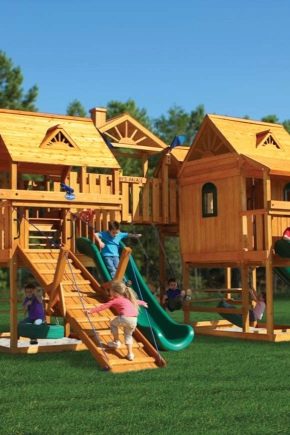
The playground where children will play is no less important attribute of any neighborhood or just a yard than shops, schools, and other facilities. It is not for nothing that when selling real estate, an emphasis is placed on it along with other elements. But doing everything right is more difficult than it seems, you need to take into account many nuances and subtleties.
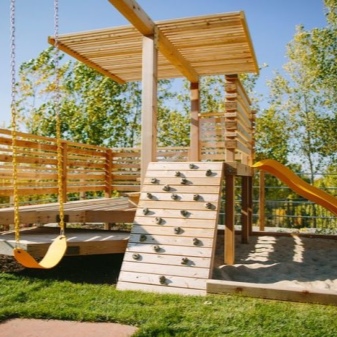
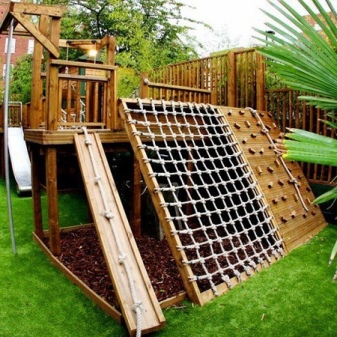
General requirements for arrangement
We are talking about the fundamental points that must be ensured in any case. It doesn't matter if the site is being prepared:
- for giving;
- for the courtyard of an apartment building;
- for a large microdistrict;
- for a city cottage;
- for a country house.
For all the seeming lightness and simplicity of the upcoming work, one cannot avoid drawing up projects. It is much easier to correct mistakes on paper or in a special computer program than after completion of construction. The "three whales" for the playground are:
- security;
- maximum functionality;
- convenience and compliance with the requirements, needs of babies (in that order).
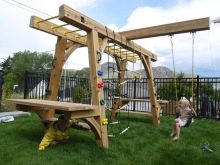

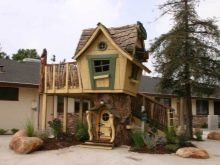
Since children cannot fully ensure their own safety, much depends on adults, on their timely assistance in a number of cases. And therefore, the playground should be as accessible as possible for review. Ideally, it should be made fully observable from all places where adults or at least adolescents will be systematically. Usually such places are the windows of the nearest house and the rooms hiding behind them. But many dangers can be foreseen and eliminated in advance.
It is not recommended to place playgrounds:
- near garages;
- directly at the carriageway;
- on the banks of rivers, lakes, swamps;
- next to transformer booths, power lines, railway and tram tracks, gas cylinders and gas stations.
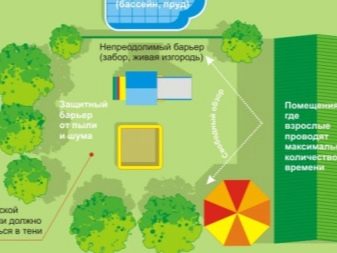
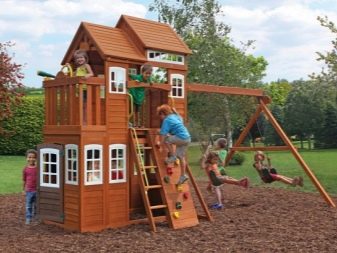
When preparing the site for work, you need to carefully check if there are any cables of various kinds, metal objects and voids in the ground. If possible, it is worth moving the site away from the pool. Builders should try to make the area as flat as possible and cover it with soft material.
Falls during active games are completely inevitable, and the harder the coverage, the more dangerous the area for children. When drawing up a project, it is necessary to indicate not only the details themselves, which will fit in certain places, but also their dimensions.
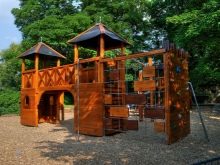
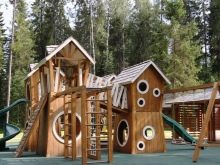

Age preferences of children
The restriction to wooden structures is quite reasonable: they can be completely made by hand. At the same time, the tree allows you to satisfy the request of children of any age. Almost every site is equipped with:
- sandbox;
- swing;
- slide.
At first, the adults themselves will have to lift the kids up the slide and swing them on the swing. But very soon this time will end, and the independent development of the surrounding space will begin.
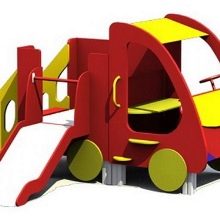
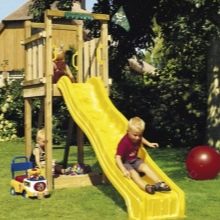
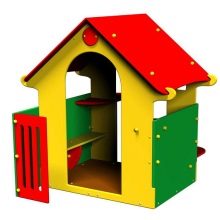
Younger preschoolers, having learned to move by themselves, prefer themed games. They can be both collective and solitary, but in any case they are focused on the development of fine motor skills, concentration of attention. Accordingly, the most popular elements include:
- "Fabulous houses";
- sandboxes;
- other designs that allow you to gain experience of interacting with the outside world.
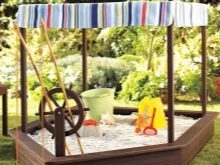
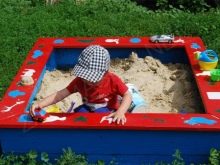
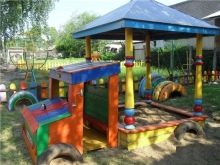
But at the age of 7-9, the priorities are completely different: climbing walls, high-altitude slides, and other attractions designed strictly for active leisure are required. As children grow older, the filling of play objects becomes more complicated.
Teenagers already need obstacle lines, horizontal bars, punching bags, basketball courts, hockey and football pitches, tennis courts. In houses where a large family lives, as well as for microdistricts or even separate city yards, it is necessary to put elements designed for different ages. This is exactly what architects do when planning a territory for a new development.
One area is necessarily allocated for active games. Objects are placed there, allowing you to climb up, and the ropes are suspended. It is recommended to leave free space for jogging and other activities. In another area, everything is done for role-playing and relaxing entertainment. It is here that "trains", houses are set up, sandboxes are broken.
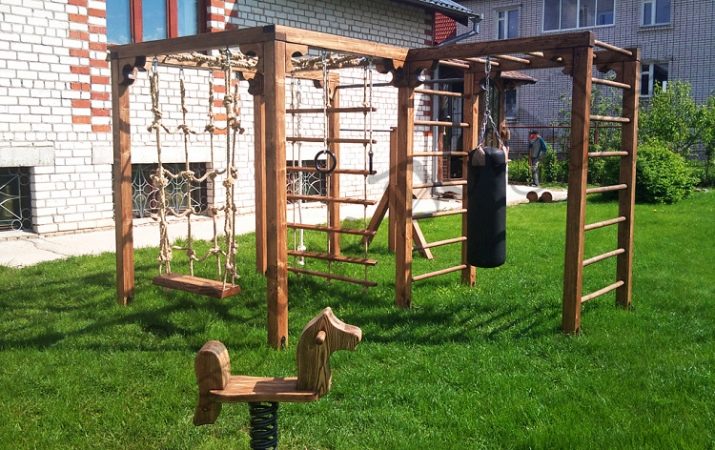
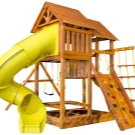
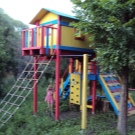
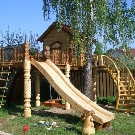
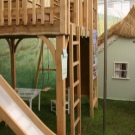
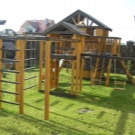
In addition to these objects, the allocation of a part for leisure is quite widely practiced. There are gazebos and awnings, tents are stretched. In a simpler case, they are limited to laying out flower beds next to the benches. Regardless of these decisions, it is recommended to think equally about the comfort for adults and children. Of the additional parts, a sports obstacle course and an area for board games can be of considerable benefit.
With the help of rocker balancers, it is easy to please children from 3 to 7 years old. But it is important to understand that not all of them are safe enough. You should only purchase products that are equipped with proper handrails. Spring rockers are suitable as early as 2-3 years old, preference should be given to products of an unusual shape and bright, juicy color. It contributes to the retention of attention and the development of imagination.
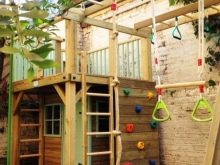
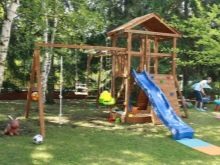

Although a swing is sometimes considered a somewhat stereotyped element, it should be mandatory. Children of any age will be happy to use them. For visitors to the kindergarten, it is necessary to mount a low structure, the seat of which is fenced. Later, a different solution is required: with an open seat, with a high rise and significant travel. In the courtyard of an apartment building, paired swings or a selection of several dissimilar elements are placed, then everyone will be able to use the impromptu attraction.
If you have to equip the territory for teenagers, it is very important to create complex climbing structures. This complexity will only benefit, helping to improve the musculoskeletal system and orientation in space, to train flexibility, endurance. The higher and steeper the slide, the older its users should be. It must be borne in mind that a safety area is created around each attraction. It cannot be occupied with other entertainment products or used in any other way.
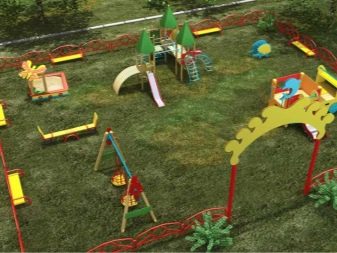
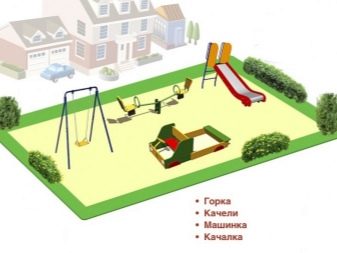
Design stages
Let's consider how to put into practice a wooden playground.
Choosing a place and type of coverage
It is not enough to prepare drawings, even with the exact dimensions of specific attractions and single details. It is important to take into account the subtleties when selecting a territory. In part, this has already been discussed, but besides security, we must pay attention to other points. So, the construction of a sandbox under the canopy of trees or tall bushes is irrational. Various debris will fall from there.
You should also avoid placing playgrounds near steep cliffs, official and unregistered dumps (garbage dumps). In private houses and summer cottages, “restricted areas” are places close to wells, toilets and septic tanks. During the day, the area should be illuminated by the sun for at least several hours, and it is optimal when this happens in the morning. Around 12 o'clock, at least part of the site should be covered with shade. Where there will be no shade, place the pool correctly in order to warm up the water in it faster.

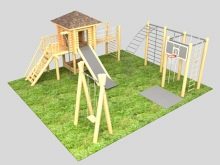
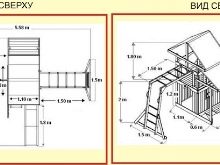
The size of the allotted area should allow the free movement of children without losing sight of each other. Therefore, ideally, you need to think about how you can see the rest of the site from any point on the site. Of all types of wood, pine is best suited for creating decorative elements. She tolerates active contact with moisture well. In addition, this breed:
- does not fade or fade little in the sun;
- slightly susceptible to jerks of temperature;
- extremely rarely becomes a breeding ground for pathological microorganisms (which is important in case of blows and injuries).
It is clear that a playground covering must guarantee safety in every way. In the event of a fall or just a blow, the occurrence of injuries is unacceptable. An indirect consequence of this requirement is the mandatory dryness and non-slip. It is very important that the site is easy to clean. Grass and sand are not suitable because they quickly absorb foliage, street debris, twigs and many other contaminants (sometimes very dangerous).
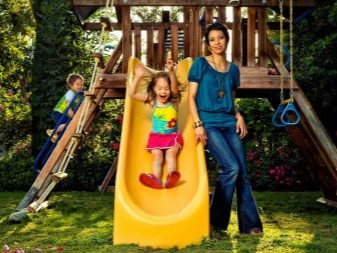

Therefore, it is recommended to give preference to artificial turf. Certified rubber or flawless plastic is totally chemical inert. Even prolonged contact with exposed skin will not harm.
Important: you cannot use car tires and their parts for flooring on the playground. Pretty soon the rubber will wear off, exposing the sharp steel cord. Contrary to the assurances of manufacturers, it is difficult to consider artificial grass a soft material. In addition to increased rigidity, such a coating is easily saturated with dirt. As for rubber coatings, their external similarity does not mean common characteristics.
The structure of a substance and its degree of hardness can vary significantly. A set of plastic tiles is most convenient in work and during subsequent care.
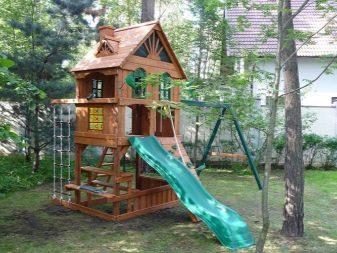

Drawing up a diagram
When forming the scheme, there is strict unambiguous rules:
- the sandbox is placed closest to the house or to the entrance to the site;
- the path of movement of the swing and the descent from the slide should not be directed towards the sandbox;
- if the previous point cannot be observed, a gap of at least 3 m is required;
- it is prohibited to orient all slides and swings towards highways and driveways.
Separation of space inside by fences is undesirable. After all, children will inevitably strive to penetrate where they are not allowed. Curiosity is a very strong incentive for this. It is better to fence off the shores of a reservoir, park, utility yard and similar dangerous places with wattle fences. They combine high strength, wind resistance, excellent aesthetic properties, are positively perceived by children (not as a strict ban).
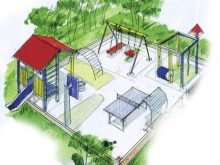
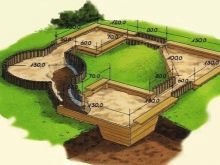
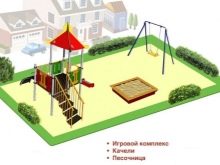
Manufacturing
A sandbox is made by digging specially selected boards or log cuts into the ground. Start work by taking off the ground; then the base is covered with a drainage layer. It is advisable to equip the slide with a plastic ramp, which is stronger than plywood and has excellent friction. You can make the simplest rope swing using a couple of racks and a fairly strong tree branch. The racks are buried 90 cm in the ground, the hole is filled with a brick fight, and then poured with concrete.
Next, the racks must be tied with a transverse structure; it is best to additionally strengthen it with a steel strip. As for the houses, the simplest option is a folding fabric tent. The frame made of wood is slightly more reliable. It is covered with the same cloth.
And the most advanced option is a construction from a bar or rounded wood.
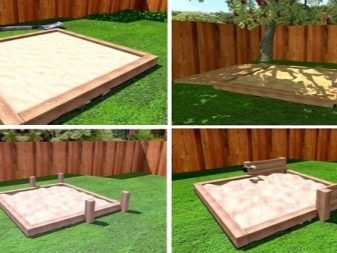
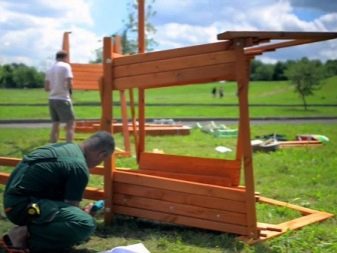
Successful examples
- Wooden playgrounds can be made like this - this is an example of an original combination of a house, a slide and several sports equipment. It is imperative that the design takes up a minimum of space.
- The developers of this site were also able to implement these functions, but already serving them in the key of a knight's castle.
- And here the bet was made on a variety of devices for the descent.This place is more likely for young children who are not yet fond of sports.
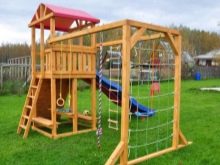

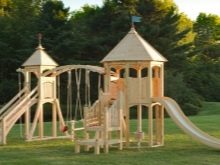
For information on how to create a wooden playground with your own hands, see the next video.













The comment was sent successfully.